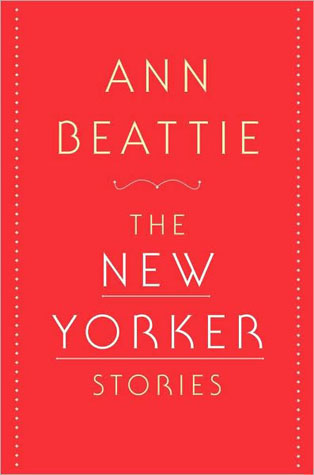
by by Margaret Kolb

Published by Scribner, 2010 | 514 pages
Ann Beattie published her first story in The New Yorker in April 1974, when she was 26. In the story, a young woman leaves her husband, finds a roommate named Sam, and grows attached to his quiet, docile presence. Sam eventually buys a motorcycle and moves out to explore the country. The woman goes back to her husband. At the story’s close, the woman pictures herself riding away on a motorcycle, journeying off with Sam. The action is both subdued and rapid; without close attention, one might not see it at all. The ending is ambivalent. Does the woman yearn for independence? Is she disappointed in herself? Is she resigned to life with her husband? Trapped? Both? Here, Beattie offers a clue about what would become a main draw of her work to follow: an ambiguity that gives her characters depth and her plots the ruddy complexity of life.
Ann Beattie’s The New Yorker Stories, a collection of the 48 stories she published in The New Yorker from 1974 to 2006, can be read as a series of vignettes on Tolstoy’s platitude “happy families are all alike; every unhappy family in unhappy in its own way.” Ann Beattie’s stories are about relationships, and rarely happy ones. A man who has just lost an arm in a car crash rejects all his relatives’ consolations; a pregnant woman visits her boyfriend’s inconsiderate family; a professor’s spouse endures his affairs with female students. Beattie understands that the devastation is in the details, and communicates the self-perceived mediocrity and failure of her character’s lives in simple images. In the vivid specifics of these stories, one understands why Beattie became so crucial in the 80s, and why she remains crucial to this day.
The stories take place in an upper East Coast upper-middle-class setting. Disillusionment and suffering intermingle with the Northeastern landscape: “the inevitable sadness that set in, always unexpectedly, but so real that it was met with the instance acceptance one gave to a snowfall.” One finds the coldness of the New England landscape, too, in many of the characters here, even as Beattie’s empathetic treatment of them reveals an underlying narrative warmth.
The New Yorker Stories is impressive in its consistency. Beattie displays little development over her career; even in her first stories one finds her fully mature. The stories change and grow over time, but subtly. Beattie herself acknowledged, in an interview with The Paris Review, only having “a certain bag of tricks.” The plots are domestic: a tense conversation, a neighbor stopping by the house, a lovers’ spat. Often, a stranger intervenes in the final page or so, prompting a minor epiphany. The end is never a clean break or a fanfare. Rather, we get a subtle gesture, a grace note that leads into a final chord that doesn’t quite arrive. This is less a collection to be read front to back, and more one to be browsed, relished, a story here and a story there.
Beattie’s characters are often unsavory, or at least petty. She has an eye for the quotidian, for the downtrodden, for the drifting and self-absorbed. There’s nothing glamorous and everything recognizable about their domesticity and plainness. Yet Beattie isn’t judging. She’s not an analyst from afar, but rather a reporter on the front lines. She relates the failed marriages and tedious, tense family get-togethers with a journalistic eye for detail. Where the epic poets enumerated their heroes’ strengths and virtues, Beattie lists the contents of a woman’s kitchen counter: unused paperclips, loose aspirin, an unopened zester bought from a door to door salesman. In such details we learn something of the character who bought this zester, and settle into the terrain of domestic life, in all its gritty plainness.
Beattie has an eye for the small failings that slowly kill relationships. In this respect, she rivals Fitzgerald, with his retellings of social resentments, aggressions and cheap judgments. In Beattie, for example, a professor’s partner offers a window into the crumbling foundation of their life together:
He pretends to like small, elegant things. Actually, when they visit museums in New York he goes first to El Grecos and big Mark Rothko canvases. She could never get him to admit that what he said or did was sometimes false.The woman – the same professor’s wife mentioned above – cooks for his lovers and feigns simplicity for most of the story. But here we find her insight to be canny and destructive. Beattie’s stories work within the sad truth that we’re hardest on those closest to us, and that they can hurt us most.
Beattie has crafted a prose to match her hawkish eye for details. It’s been called bare-boned, terse, and simple, and it remains recognizably Beattie. Like Carver, Mason, and Hemingway, Beattie’s use of literary “white space” makes her prose more powerful. Her observations stand stark and unadorned:
I have a lover. He comes on Thursdays. He would come more frequently, but I won’t allow it. Jonathan is twenty-one and I am thirty-three, and I know that eventually he will go away.Amidst this sparseness, Beattie is a master at combining irony and intimacy. Her voice can be wry without being cruel, journalistic without being distant. When The New Yorker began running her stories, this voice felt fresh – so fresh that it spawned its own adjective, Beattiesque, that’s since been applied to everyone from Bharati Mukherjee to Peter Cameron to Tao Lin.
In her creative writing classes at the University of Virginia, Beattie likes to tell her students that, “[I]t’s an advantage to work with open-ended, messy moments.” Indeed, messy moments are the core of her own work. Throughout her career, Beattie’s been called many things: a New Yorker school writer, a K-Mart Realism writer, even a “Frank went to stand by the window” writer. Categories aside, what she’s working with story after story are people, lonely people with messy day-to-day existences. More than just the pulse of a generation, her stories have their thumb on the pulse of life itself: irregular, panting and interminable, there driving us along beat by beat nevertheless.
Erin Becker is an English teacher in Santiago, Chile, a graduate of the English and Creative Writing program at the University of North Carolina at Chapel Hill, and a native of Cedar Rapids, Iowa. Her interests include the relationship between propaganda and literature, writers during wartime, and contemporary media discourse.















click to see who
MAKE Magazine Publisher MAKE Literary Productions Managing Editor Chamandeep Bains Assistant Managing Editor and Web Editor Kenneth Guay Fiction Editor Kamilah Foreman Nonfiction Editor Jessica Anne Poetry Editor Joel Craig Intercambio Poetry Editor Daniel Borzutzky Intercambio Prose Editor Brenda Lozano Latin American Art Portfolio Editor Alejandro Almanza Pereda Reviews Editor Mark Molloy Portfolio Art Editor Sarah Kramer Creative Director Joshua Hauth, Hauthwares Webmaster Johnathan Crawford Proofreader/Copy Editor Sarah Kramer Associate Fiction Editors LC Fiore, Jim Kourlas, Kerstin Schaars Contributing Editors Kyle Beachy, Steffi Drewes, Katie Geha, Kathleen Rooney Social Media Coordinator Jennifer De Poorter
MAKE Literary Productions, NFP Co-directors, Sarah Dodson and Joel Craig